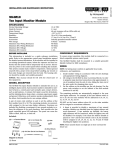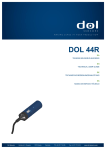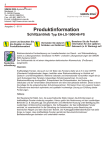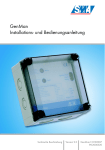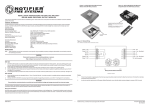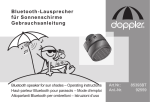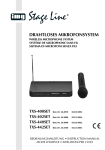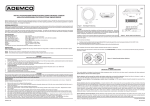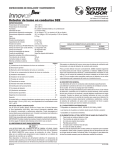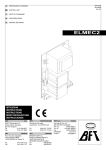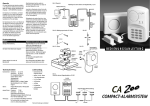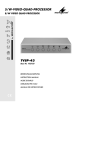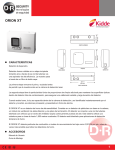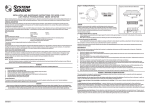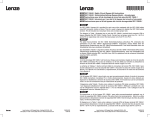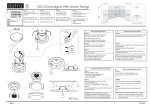Download Descargar
Transcript
INSTALLATION AND MAINTENANCE INSTRUCTIONS CR-6 Six Relay Control Module SPECIFICATIONS Normal Operating Voltage: Stand-By Current: Alarm Current: Temperature Range: Humidity: Dimensions: Maximum IDC Wiring Resistance: Accessories: Wire Gauge: Relay Current: CURRENT RATING 3A 2A 1A .5A Pittway Technologica S.p.A Via Caboto 19/3 34147 Trieste, Italy 15-32 VDC 1.45 mA 32 mA (assumes all six relays have been switched once and all six LEDs solid on) -10°C to 55°C 10 to 93% Non condensing 17.3cm H x 14.7cm W x 3.2cm D 40 ohms Suitably grounded metallic cabinet 0.9mm2 - 3.25mm2 30 mA/Relay Pulse (15.6 mS pulse duration) pulse under panel control MAXIMUM VOLTAGE 30VDC 30VDC 30VDC 30VDC LOAD DESCRIPTION Resistive Resistive Inductive (L/R=2ms) Inductive (L/R = 5ms) BEFORE INSTALLING This information is included as a quick reference installation guide. If the modules will be installed in an existing operational system, inform the operator and local authority that the system will be temporarily out of service. Disconnect the power to the control panel before installing the modules. This system contains static sensitive components. Always ground yourself with a proper wrist strap before handling any circuits so that static charges are removed from the body. The housing cabinet should be metallic and suitably grounded. APPLICATION Non Coded Coded Coded Coded ing modules are automatically assigned to the next five higher addresses. Provisions are included for disabling a maximum of three unused modules to release the addresses to be used elsewhere. Each CR-6 module also has panel controlled green LED indicators. The panel can cause the LEDs to blink, latch on, or latch off. Contents include: (6) 1 x 3 Terminal Blocks (5) 1 x 4 Terminal Blocks (2) 3.2 cm Stand offs NOTICE: This manual should be left with the owner/user of this equipment. (2) Screws GENERAL DESCRIPTION The CR-6 Six Relay Control Module is intended for use in an intelligent alarm system. Each module is intended for Form-C switching applications, which do not require wiring supervision for the load circuit. A single isolated set of dry relay contacts is provided for each module, which is capable of being wired for either normally open or normally closed for each operation. Each module has its own address. A pair of rotary code switches is used to set the address of the first module from 01 to 94. The remain- D500-65-00 (1) Shunt (NOTE: For the disable position, not more than one shunt shall be installed at the same time) COMPATIBILITY REQUIREMENTS To ensure proper operation, this module shall be connected to a compatible control panel only. The CR-6 Module shall be mounted in a suitably grounded Metallic Cabinet for EMC compliance. 1 I56-2255-01 WIRING NOTE: All wiring must conform to applicable local codes, ordinances, and regulations. 1. Install module wiring in accordance with the job drawings and appropriate wiring diagrams. 2. Make electrical connections by stripping approximately 5 mm of insulation from the end of the wire sliding the bare end of the wire under the clamping plate, and tightening the clamping plate screw. 3. Set the address on the modules per the job drawing. Use the rotary code switches to set the address of the first module (between 01 and 94). The remaining modules are automatically assigned to the next five higher BASE ADDRESS N.C. N.O. COMMON N.C. 5.8" COMMUNICATION LINE 32 VDC MAX. TWISTED PAIR IS RECOMMENDED N.O. COMMON N.C. N.O. COMMON N.C. N.O. COMMON ADDRESS 5 NC NO COMMON ADDRESS DISABLE NONE ONE TWO THREE SLC – + STATUS INDICATORS – + TO NEXT DEVICE + – + – ADDRESS 4 COMMON 5 4 3 2 10 ADDRESS 3 N.C. N.O. 5 4 3 2 10 RELAY CONNECTIONS 6789 ADDRESS 2 N.O. COMMON ADDRESS 1 N.C. + 6789 ADDRESS 0 FROM PANEL OR PREVIOUS DEVICE – addresses. For example, if the base address switch is set to 28, the next five modules will be addressed to 29, 30, 31, 32, and 33. DO NOT set the lowest address above 94, as the other modules will be assigned to nonexistent addresses. 4. A shunt is provided to disable a maximum of three unused modules. Modules are disabled from the highest address and work downward. If two modules are disabled, the lowest four addresses will be functional, while the highest two will be disabled. For example, if the shunt for Address Disable is placed on “two” and the base address switch is set to 28, the modules will be assigned to 28, 29, 30 and 31. 6.8" Figure 1: Wiring and programming the CR-6 module D500-65-00 2 I56-2255-01 ISTRUZIONI DI INSTALLAZIONE E MANUTENZIONE CR-6 Modulo di controllo a sei relè SPECIFICHE Normale tensione di esercizio: Corrente in stand-by: Corrente di allarme: Range di temperatura: Umidità: Dimensioni: Massima resistenza del cablaggio IDC: Accessori: Sezione conduttori: Corrente del relè: Pittway Technologica S.p.A Via Caboto 19/3 34147 Trieste, Italy 15 - 32 VDC 1.45 mA 32 mA (a condizione che tutti i sei relè siano stati attivati una volta e che tutti i sei LED siano accesi in modo fisso) da -10°C a 55°C dal 10 all 93% senza formazione di condensa A 173 mm x L 147 mm x P 25 mm 40 ohm Cabinet metallico dotato di un’adeguata messa a terra 0.9 mm2 - 3.25 mm² 30 mA/Impulso relè (durata dell’impulso 15.6 mS) impulso controllato dal pannello POTENZA NOMINALE CORRENTE TENSIONE MASSIMA DESCRIZIONE DEL CARICO APPLICAZIONE 3A 30 VDC Resistivo continuo 2A 30 VDC Resistivo impulsivo 1A 30 VDC Induttivo (L/R = 2 ms) impulsivo .5 A 30 VDC Induttivo (L/R = 5 ms) impulsivo PRIMA DELL’INSTALLAZIONE Le informazioni qui riportate fungono da guida all’installazione di consultazione rapida. In caso di installazione dei moduli in un sistema operativo già funzionante, informare l’operatore e le autorità locali che il sistema rimarrà temporaneamente fuori servizio. Prima di installare i moduli, scollegare l’alimentazione del pannello di controllo. Il sistema contiene componenti sensibili elettricità staticà. Prima di maneggiare qualsiasi tipo di circuito, collegarsi sempre a massa utilizzando un’apposita fascia che respinge le cariche statiche dal corpo. È importante che la struttura del cabinet sia metallica e adeguatamente collegata a massa. vengono automaticamente assegnati i cinque successivi indirizzi più alti. La disabilitazione di un massimo di tre moduli non utilizzati è regolata da particolari disposizioni che consentono di riutilizzare altrove questi indirizzi. Ogni modulo CR-6 dispone anche di indicatori LED di colore verde controllati dal pannello. A seconda delle istruzioni del pannello, i LED possono lampeggiare, essere attivati oppure disattivati. La confezione contiene: (6) 1 x 3 morsettiere (5) 1 x 4 morsettiere (2) Stand off da 32 mm AVVISO: Il presente manuale deve essere consegnato al proprietario/all’utente di questo apparecchio. (2) Viti DESCRIZIONE GENERALE Il modulo di controllo a sei relè CR-6 è stato progettato per l’uso in sistemi d’allarme intelligenti. Ogni modulo è destinato ad applicazioni di switching con modulo C che non richiedono la supervisione del cablaggio del circuito di carico. Ogni modulo è dotato di un unico set isolato di contatti per relè a secco, in grado di essere cablato in modalità normalmente chiusa o normalmente aperta a seconda del tipo di funzionamento. Ogni modulo possiede un proprio indirizzo. Per impostare l’indirizzo del primo modulo su un valore compreso tra 01 e 94, utilizzare la coppia di switch con codice a rotazione. Ai restanti moduli D500-65-00 (1) Derivazione (NOTA: Per lo stato di disabilitazione, non installare più di una derivazione alla vota) REQUISITI DI COMPATIBILITÀ Per garantire un corretto funzionamento, collegare questo modulo solo ad un pannello di controllo compatibile. Il modulo CR-6 deve essere montato all’interno di un contenitore metallico collegato a massa per incontrare i requisiti di compatibilità elettromagnetica. 3 I56-2255-01 CABLAGGIO NOTA: l’intero cablaggio deve essere conforme a tutte le normative, ordinanze e disposizioni locali vigenti. 1. Installare il cablaggio del modulo conformemente ai diagrammi di lavoro e ai relativi schemi di cablaggio. 2. L’intero cablaggio del CR-6 passa attraverso delle morsettiere Per eseguire le connessioni elettriche, rimuovere circa 5 mm di materiale isolante dall’estremità del filo e far passare l’estremità scoperta del filo sotto la piastra di fissaggio e serrarne la vite. 3. Impostare l’indirizzo dei moduli secondo il diagramma di lavoro. Per impostare l’indirizzo del primo modulo (valore compreso tra 01 e 94) utilizzare gli switch con codice a rotazione. Ai restanti moduli vengono automaticamente assegnati i cinque successivi indirizzi più alti. Se ad esempio l’indirizzo dello switch di INDIRIZZO DI RIFERIMENTO N.C. N.O. TRADIZIONALE N.C. 5.8" LINEA DI COMUNICAZIONE MAX. 32 VDC SI CONSIGLIA UN CAVO TWISTED PAIR N.O. TRADIZIONALE N.C. N.O. TRADIZIONALE N.C. N.O. INDIRIZZO 5 NC NO COMUNE INDIRIZZO DISABILITA NESSUNO UNO DUE TRE TRADIZIONALE SLC – + INDICATORI DI STATO – + AL DISPOSITIVO SUCCESSIVO + – + – INDIRIZZO 4 TRADIZIONALE 5 4 3 2 10 INDIRIZZO 3 N.C. N.O. 5 4 3 2 10 CONNESSIONI DEL RELÈ 6789 INDIRIZZO 2 N.O. TRADIZIONALE INDIRIZZO 1 N.C. + 6789 INDIRIZZO 0 DAL PANNELLO O DAL DISPOSITIVO PRECEDENTE – riferimento è impostato su 28, ai cinque moduli successivi verranno assegnati gli indirizzi 29, 30, 31, 32 e 33. NON impostare l’indirizzo più basso su un valore superiore a 94, poiché agli altri moduli verrebbero assegnati indirizzi inesistenti. 4. Per disabilitare un massimo di tre moduli non utilizzati è disponibile una derivazione. I moduli vengono disabilitati a partire da quello con l’indirizzo più alto e funzionano verso il basso. Se vengono disabilitati due moduli, i quattro moduli con l’indirizzo più basso rimarranno funzionanti mentre i due con l’indirizzo più alto verranno disabilitati. Se ad esempio la derivazione per la disabilitazione dell’indirizzo si trova su “due” e l’indirizzo dello switch di riferimento è impostato su 28, ai moduli verranno assegnati gli indirizzi 28, 29, 30 e 31. 6.8" Figura 1: Cablaggio e programmazione del modulo CR-6 D500-65-00 4 I56-2255-01 INSTRUCCIONES DE INSTALACIÓN Y MANTENIMIENTO CR-6 Módulo de control con seis circuitos de salida en forma relé ESPECIFICACIONES Tensión de Funcionamiento Normal: Corriente en resposo: Corriente en Alarma: Rango de temperatura: Humedad: Dimensiones (mm): Máxima Resistencia IDC del cable: Accesorios: Sección del Cable: Corriente del Relé: 15-32 VDC 1,45 mA 32 mA (asumiendo que los seis relés han sido conectados una vez y los seis LEDs están iluminados de forma fija) de -10°C a 55°C; 10 a 93% No condensada 185 (alto) x 147 (ancho) x 25 (fondo) 40 ohmios Cabina metálica conectada adecuadamente a tierra 0,9mm2– 3,25mm2 30 mA/ Pulso de Relé (15,6 ms duración del pulso) pulso bajo control de panel CORRIENTE TENSIÓN MÁXIMA DESCRIPCIÓN DE LA CARGA APLICACIÓN 3A 30VDC Resistiva Fija 2A 30VDC Resistiva Intermitente 1A 30VDC Inductiva (L/R=2ms) Intermitente .5A 30VDC Inductiva (L/R = 5ms) Intermitente asignarán automáticamente las siguientes cinco direcciones numéricas. Se incluye la posibilidad de desactivar un máximo de tres módulos no utilizados, cuyas direcciones se pueden liberar y utilizar en otro lugar. Cada módulo CR-6 dispone también de leds indicadores verdes controlados desde el panel. Desde el panel se puede hacer que estos leds parpadeen, se mantengan iluminados de forma fija o se apaguen. ANTES DE LA INSTALACIÓN Esta información se utiliza como guía rápida para la instalación. Consulte el manual de instalación correspondiente al panel de control para obtener información deta-llada sobre el sistema. Si los módulos se van a instalar en un sistema operativo ya existente, informe al usuario y a la autoridad local de que dicho sistema estará temporalmente fuera de servicio. Desconecte la alimentación antes de instalar los módulos. Este sistema contiene componentes sensibles a la electricidad estática. Utilice una pulsera de conexión a tierra para manipular los circuitos de modo que se eliminen las cargas estáticas. La carcasa del módulo también debe estar conectada a tierra. AVISO: El contenido del paquete incluye: (6) 1 x 3 Bloques de Terminales (5) 1 x 4 Bloques de Terminales (2) Separadores 32mm Este manual debe permanecer al alcance del propietario/usuario del equipo. (2) Tornillos DESCRIPCIÓN GENERAL El Módulo de Control CR-6 ha sido diseñado para su uso en un sistema de alarma inteligente. Cada módulo se utiliza en aplicaciones con relés en Forma C, que no necesitan supervisión por cable desde el circuito de carga. Para cada módulo se proporciona un único conjunto de relés de contacto seco, capaz de conectarse de forma normalmente abierta o normalmente cerrada en cada operación. Cada módulo tiene su propia dirección. Para configurar la dirección del primer módulo de 01 a 94 se utiliza el par de selectores rotatorios. Al resto de los módulos se les D500-65-00 Pittway Technologica S.p.A Via Caboto 19/3 34147 Trieste, Italy (1) Puente (NOTA: En la posición de “anulado”, no se puede instalar más de un puente al mismo tiempo) COMPATIBILIDAD Para asegurar un funcionamiento adecuado, conecte este módulo sólo a un panel de control compatible. El CR-6 debe montarse en una cabina metálica conectada adecuadamente a tierra para cumplir con la directiva de compatibilidad electromagnética CEM. 5 I56-2255-01 CABLEADO NOTA: Todos los cables deben ajustarse a los códigos, ordenanzas y regulaciones locales. 1. Instalar el cable del módulo según los dibujos y diagramas correspondientes. 2. Efectúe las conexiones eléctricas pelando aproximadamente unos 5 mm del aislante del cable, a continuación, coloque el cable pelado debajo del tornillo y enrosque el tornillo. 3. Ajuste las direcciones en los módulos según el dibujo. Utilice los selectores rotatorios para configurar la dirección del primer módulo (entre 01 y 94). Al resto de los módulos se les asignará automáticamente las siguientes cinco direcciones numéricas. Por ejemplo, si se configura N.C. N.O. COMÚN N.C. N.O. COMÚN N.C. N.O. COMÚN 6789 5 4 3 2 10 CONEXIONES DEL RELÉ NC NA COMÚN COMÚN N.C. N.O. COMÚN ANULAR SLC – + INDICADORES DE ESTADO – + AL DISPOSITIVO SIGUIENTE + – + – DIRECCIÓN NINGUNA UNA DOS TRES DIRECCIÓN 0 N.C. N.O. DIRECCIÓN 1 1 5.8" LÍNEA DE COMUNICACIONES 32 VDC MAX. SE RECOMIENDA CABLE TRENZADO DIRECCIÓN 5 N.O. COMÚN DIRECCIÓN 4 + 6789 5 4 3 2 10 DIRECCIÓN 3 – DIRECCIÓN BASE N.C. DIRECCIÓN 2 DESDE EL PANEL O DISPOSITIVO ANTERIOR la dirección base con el número 28, a los otro cinco módulos se les adjudicarán las direcciones 29, 30, 31, 32 y 33. NO debe configurar la dirección más baja por encima del número 94, ya que al resto de los módulos se les adjudicarían direcciones que no existen. 4. Se proporciona un puente para anular un máximo de tres módulos no utilizados. Estos módulos se anulan empezando por la dirección más alta. Si se anulan dos módulos, estarán operativas las cuatro direcciones inferiores, mientras que quedarán anuladas las dos más altas. Por ejemplo, si el puente de Anular Dirección se pone en el “dos”, y la dirección base se ajusta a 28, se adjudicarán a los módulos los números 28, 29, 30 y 31. 6.8" Figura 1. Cableado y programación del módulo CR-6 D500-65-00 6 I56-2255-01 INSTALLATIONS- UND WARTUNGSANLEITUNG CR-6 Sechs-Relais-Steuermodul SPEZIFIKATION Betriebsspannungsbereich: Ruhestrom: Alarmstrom: Temperaturbereich: Luftfeuchte: Abmessungen: Maximale Anschluss Impedanz: Zubehör: Kabelquerschnitt: Relaisstrom: Pittway Technologica S.p.A Via Caboto 19/3 34147 Trieste, Italy 15-32 VDC 1,45 mA 32 mA (bei 6 angesteuerten Relais und 6 dauerleuchtenden LED) -10 °C bis +55 °C 10 bis 93% ohne Betauung 173 x 147 x 25 (H x B x T in mm) 40 Ohm geerdetes Metallgehäuse 0,9mm2 – 3,25mm² 30 mA / pulsierend (15,6 ms Pulsdauer) von der Zentrale gesteuert STROMAUFNAHME MAX. SPANNUNG VERBRAUCHER APPLIKATION 3A 30VDC ohmsche Last nicht getaktet 2A 30VDC ohmsche Last getaktet 1A 30VDC Induktiv (L/R = 2ms) getaktet 0,5A 30VDC Induktiv (L/R = 5ms) getaktet VOR DER INSTALLATION Es besteht die Möglichkeit bis max. drei nicht benötigte Module abzuschalten und deren Adressbereich für andere Anwendungen frei zu geben. Diese Information dient als Kurzanleitung für die Installation. Wenn Module in bereits betriebsbereite Anlagen eingebaut werden, informieren Sie die zuständigen Personen und die regionalen Behörden, dass ggfs. die Anlage zeitweise außer Betrieb genommen wird. Schalten Sie die Zentrale vor dem Beginn der Installationsarbeiten spannungsfrei. Das System beinhaltet Bauteile mit elektrostatischer Empfindlichkeit. Erden Sie sich vor dem Umgang mit diesen Baugruppen mit einem geeigneten Erdungsband zur Ableitung der elektrostatischen Energie. Es sollten nur Metallgehäuse mit geeigneter Erdung verwendet werden. Jedes CR-6 Modul hat eine, von der Zentrale gesteuerte, grüne LED-Anzeige. Die Zentrale kann die LED blinkend, folgend ein oder folgend aus ansteuern. Im Lieferumfang enthalten: (6) 1 x 3 Anschlussklemmen (5) 1 x 4 Anschlussklemmen (2) 32mm Abstandshalter HINWEIS: Diese Anleitung sollte dem Betreiber ausgehändigt und der Anlagendokumentation beigefügt werden. ALLGEMEINES (2) Metallschrauben Das CR-6 Relais- Steuermodul wird in intelligenten Gefahrenmeldeanlagen eingesetzt. Jedes Modul ist zum Einbau auf C-Montageschienen und Installationen bei denen die Überwachung der Ausgänge nicht erforderlich ist, geeignet. Jedes Modul verfügt über einzelne potentialfreie Relaiskontakte die wahlweise als Schließer oder Öffner konfiguriert werden können. Mit den beiden Drehschaltern wird die Moduladresse von 01 bis 94 eingestellt. Den verbleibenden Modulen werden automatisch immer die nächsten, um die Zahl 5 erhöhten, Adressnummern zugewiesen. D500-65-00 (1) Steckbrücke (Hinweis: Es darf immer nur eine einzige Steckbrücke zur Adressabschaltung pro Modul gesteckt sein) KOMPATIBILITÄT Für den ordnungsgemäßen Betrieb muss das Modul an eine geeignete und kompatible Brandmelderzentrale angeschlossen werden. Das CR-6-Modul sollte für die Erfüllung der EMV-Richtlinie in einem geeigneten, geerdeten Metallgehäuse montiert werden 7 I56-2255-01 VERDRAHTUNG Stellen Sie niemals eine Erstadresse über 94 ein, weil dann die nächsten Module als nicht vorhanden interpre tiert werden. HINWEIS: Die Verdrahtung muss gemäß den regionalen Auflagen, Richtlinien und Anforderungen ausgeführt werden. 1. Installieren Sie das Module gemäß den Projek tierungszeichnungen und den entsprechenden Anschlussdiagrammen. 2. Entfernen Sie die Isolierung des Kabelendes auf ca. 5 mm Länge und schieben Sie das abisolierte blanke Kabelende unter die Klemmplatte der Schraubklemme und ziehen diese fest an. 3. Stellen Sie die Moduladresse des ersten Modules (zwischen 01 und 94) gemäß ihren Projektierungsplänen mit den Drehschaltern ein. Die verbleibenden Module werden automatisch den nächsten 9 Adressen zugeordnet. Z.B.: Wenn die Startadresse auf 28 eingestellt ist, belegen die anderen 5 Modul die Adressen 29 - 37. N.O. GEMEINSAMER N.C. N.O. GEMEINSAMER N.C. 5.8" SIGNALKABEL 32 VDC MAX. VERDRILLTE LEITUNG ERFORDERLICH N.O. GEMEINSAMER N.C. N.O. GEMEINSAMER N.C. N.O. ADRESSE 5 6789 5 4 3 2 10 Schließer Offner Mittelkontakt ADRESSE ABSCHALTUNG KEINE EINS ZWEI DREI ZUSTANDSANZEIGEN RINGBUS – + GEMEINSAMER – + ZUR NÄCHSTEN BAUGRUPPE + – + – ADRESSE 4 N.C. 5 4 3 2 10 ADRESSE 3 GEMEINSAMER RELAIS ANSCHLUSS ADRESSE 2 N.O. + MODUL ADRESSE 6789 ADRESSE 1 – N.C. ADRESSE 0 VON DER ZENTRALE ODER VORHERIGER BAUGRUPPE 4. Die mitgelieferte Steckbrücke ermöglichen die Abschaltung von max. zwei nicht benutzten Modulen. Die Module werden von der höchsten Adresse aus absteigend abgeschaltet. Wenn zwei Module abgeschaltet werden bleiben die unteren vier Adressen aktiv und die beiden höchsten Adressen werden deaktiviert. Wird die Steckbrücke zur Adressabschaltung z.B. in Position „Zwei“ gesteckt und eine Erstadresse von 28 eingestellt, so werden die anderen Adressen 28,29,30 und 31 zugeordnet, während die beiden höchsten Adressen abgeschaltet werden. 6.8" Abbildung 1: Verdrahtung und Programmierung des CR-6 Modules D500-65-00 8 I56-2255-01 ©2003 System Sensor








